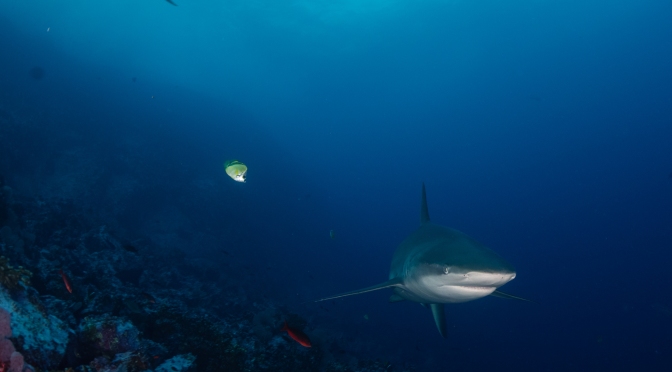In a previous post I described the use of the Canon 8-15mm as a zoom fisheye using the Kenko Teleplus HDpro teleconverted.
I had the opportunity to try this set up in Malpelo although in a situation that was not ideal for it.
I put this lens on expecting some wide angle school shots and instead it ended up being a dive with Galapagos sharks coming fairly close.
With the imminent launch of the Nauticam Fisheye Conversion Port many users will ask if they shoud invest in that or they can get decent quality at more affordable cost spending less then £800 for a teleconverter set up. I assume any Sony full frame E-mount shooters own both the Canon 8-15mm and the Sony 28-60mm.
Edit 9 March 2024
Studio Shots
I found some time to do some tests at f/16 distance 25cm which is typical of wide angle in a dome.
As you can see the kenko 1.4 TC does not loose any quality compared to the bare lens and looks more magnified at same focal lenght in the centre.


Why is the quality the same? Probably the Canon 8-15mm is a better lens at 10.7mm that it is at 15mm and therefore even with the teleconverters result match. This corroborates my in water results.
Malpelo Shots Analysis
The dive was early in the morning and topside overcast resulting in a fairly dark dive.
The sharks came fairly close however as soon as the strobe fired they turned on their back. My impression was that this was more due to the noise of the strobe firing then the actual light.
All my shark shots are at f/8 1/30 ISO 500. As the shutter speed is quite low you have situations where the subject is sharp but some of the fish at the edges has some motion blur this is unrelated to the lens.

If you open the above image on a separate tab and zoom 100% you will see that the shark is pin sharp and so are the small fish on the same focal plane and the one behind. The reef on the left bottom corner is soft.
This has to be expected as the focal point is further back from the shark so the camera is out of depth of field on that corner.
The situation repeats in other shots like this one where the shark is even closer however the edge improves due to the reduced distance gap with the reef.


Again shot after shot the fact I was focussing on the shark that was deeper in the frame resulted in the left edge being soft, this has to be expected and there is nothing wrong with the set up the dome or else.
I took some shots really close on the reef at f/16 to make the point here the muray eel is sticking out of the reef so the edges look much better.

This other shot has an hawkfish in the edge you can still see the coloration and the eyeball of the fish.

Conclusion
In general terms shooting f/8 on full frame is not an example of small aperture in fact this is a setting for distant subjects almost and wide angle scenes. In the environmental situation I was in I could have increased the ISO to achive higher shutter speed and smaller aperture however this would have resulted in more noise and loss of resolution across the whole frame. My view is that for general wide angle where there is no clear subject you can try to focus closer to have the edges sharper however this is not always a possibility with sharks and things moving and furthermore there is rarely anything of interest in the edges.
This was my second time with this combination and I remain of the opinion that the teleconverter does not take anything away in the center of the frame and deteriorates the edges only just slightly and is therefore a worth addition. The nauticam FCP is not yet released and combined with the 28-60mm will for sure produce a more flexible set up because of the increased zoom range compared to the teleconverter however if this produces better image quality on the overlapping range remains to be seen. I expect it will cost considerably more than the £800 required to add the teleconverter to your Canon 8-15mm.















